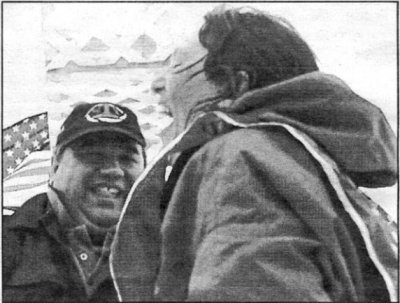

 Rick Larson and his team of dogs was the first to cross the finish line on Monday, completing a difficult 247-milejourneythrough the northern Maine woods. On the final leg of the three-day race, Larson battled with Yukon Quest Hall of Famer and three-time Can-Am champion Don Hibbs, warm temperatures, and a recent snowfall to claim the 2007 Can-Am Crown. --Birden photo--
Rick Larson and his team of dogs was the first to cross the finish line on Monday, completing a difficult 247-milejourneythrough the northern Maine woods. On the final leg of the three-day race, Larson battled with Yukon Quest Hall of Famer and three-time Can-Am champion Don Hibbs, warm temperatures, and a recent snowfall to claim the 2007 Can-Am Crown. --Birden photo--
|
 Rita Wehseler expresses deep emotion as she once again places herself in the history books of the Can-Am Crown dogsled race by being the first woman to come in second place in the Cm~-Am250. In 2001, Wehseler achieved distinction as the first woman to finish the difficult race. Mushers say the race is more challenging than the famous 1ditarod and call the event, hosted in Fort Kent, the best race in the lower 48 states. --Birden photo--
Rita Wehseler expresses deep emotion as she once again places herself in the history books of the Can-Am Crown dogsled race by being the first woman to come in second place in the Cm~-Am250. In 2001, Wehseler achieved distinction as the first woman to finish the difficult race. Mushers say the race is more challenging than the famous 1ditarod and call the event, hosted in Fort Kent, the best race in the lower 48 states. --Birden photo--
|
| By Andrew Birdon
FORT KENT - "It's good to be here," said Rick Larson as his team of 10 dogs came to a halt on the winning side of the finish line of the Can-Am 250. Larson, of Sand Coulee~ Mont., pulled into Fort Kent at - 11:51 a.m. Monday, completing a grueling 247.4 miles in 34 hours, 33 minutes and two seconds. Larson said, "As long as the weather stayed good, we had the power to do this." The latest holder of the Can-Am Crown praised the race organizers, saying they provided an excellent support service for a difficult race. He said, "It's more demanding than the Iditarod." Larson said, "This. is a great race. I'll be back." The nationally recognized musher said he heard about the Can-Am while he was racing in California. He said a friend told him "it was the best race in the lower 48." Larson completes a racing season in which he moved from state-to-state, beginning with California. He said, "I won my first race on the west coast and I won my last race on the east coast." After Larson, the crowds cheered loudly as the second place musher came down the hill towards the finish line. The cheers became shouts as spectators realized who was coming in just 16 minutes behind Larson. Rita Wehseler took the second place - position. This is the highest ranking for a female musher in the Can-Am 250. In 2001, Wehseler was the first woman to complete the 250.' Wehseler of Tofte, Minn., was physically exhausted and emotionally exuberant as she crossed the finish line. She fell across her sled as it came to a stop, exclaiming loudly. She and Larsen, both passed the race leader, Don Hibbs, a few miles outside of Fort Kent. Wehseler said she had to pass Normand Casavant, who came in after Hibbs, twice on the 57-mile leg between Allagash and Fort Kent. She said, "I didn't start kicking some ass until 10 miles out, when he re-passed me." |
After she overtook Casavant, who was forced to stop and place one of his dogs in the sled. She then came upon Hibbs. She said, "I saw Don (Hibbs) and 1 said, You're toast.'" Hibbs came in only 85 seconds after Wehseler. The race reversed a trend for shorter race times that has occurred in the past couple of years. ln 2006, Matt Carstens finished in 29 hours and 13 minutes. This year, snow and warmer weather forced the mushers to drop their speed by about 1 to 1.5 miles hour. The winners were averaging about seven· miles per hour throughout the race. Beginning on Saturday morning, after the start of the 36~miler and the 60-miler, 30 mushers left' the cheering crowds on Fort Kent's Main Street to pass into the relative quiet of the Northern Maine woods. The lead mushers pulled into Portage on Saturday night after a 67-mile trip through new snow and relatively warm 30degree temperatures. Saturday evening in Portage, snow was falling as thick as an inch an hour. The mushers started pulling in at around 7 p.m. and two mushers left a scant two hours later around 9 p.m. Both of the forerunners from Portage were forced to scratch by the time they got to Maibec. Carstens was leading the mushers as they started to pull into Rocky Brook at about 3:20 on Sunday morning. BuL Hibbs stopped for only 20 minutes before heading off to the remote camp ofMaibec, a five~hour trip. Hibbs' stayed in Maibec for about 5.5 hours before setting course_for Allagash. Racers pulled into Allagash's Two Rivers Cafe around midnight, with Hibbs holding a respectable lead, where they each took ·a mandatory five-hour test break. The top three finishers, with Hibbs leading, left Allagash around 5a.m. Larson overtook Hibbs around nine miles outside of Fort Kent. As of 2 p.m. on Sunday, nine of the 30 mushers had scratched from the race. Dr. Nick Pesut, head veterinarian for the races, said there were only minor injuries to some of the dogs, mainly lameness and exhaustion because of the warm weather. |